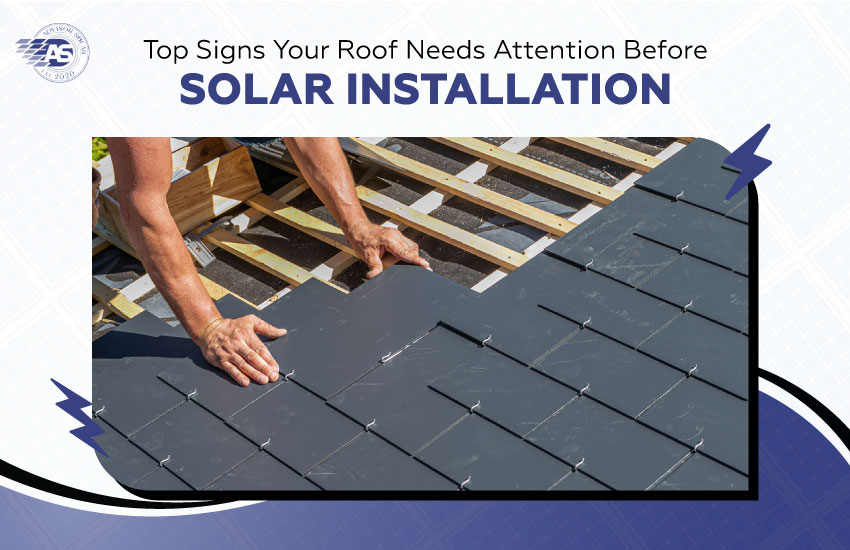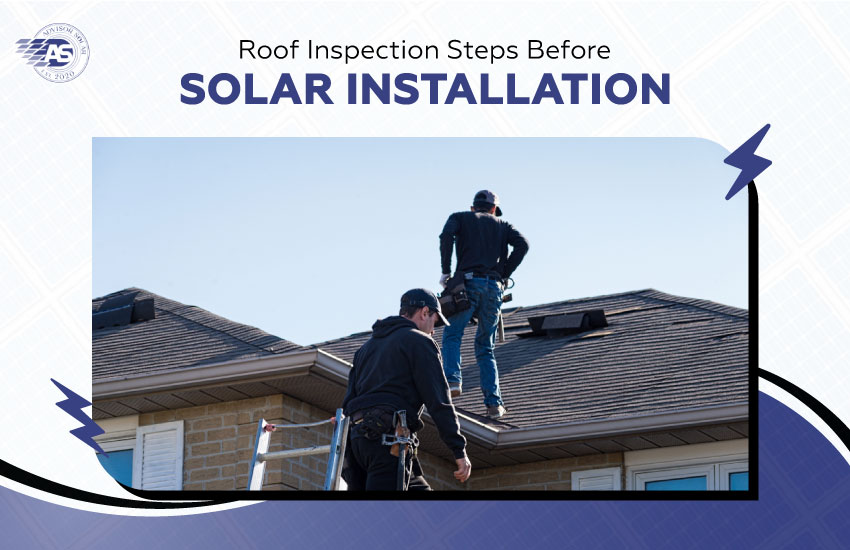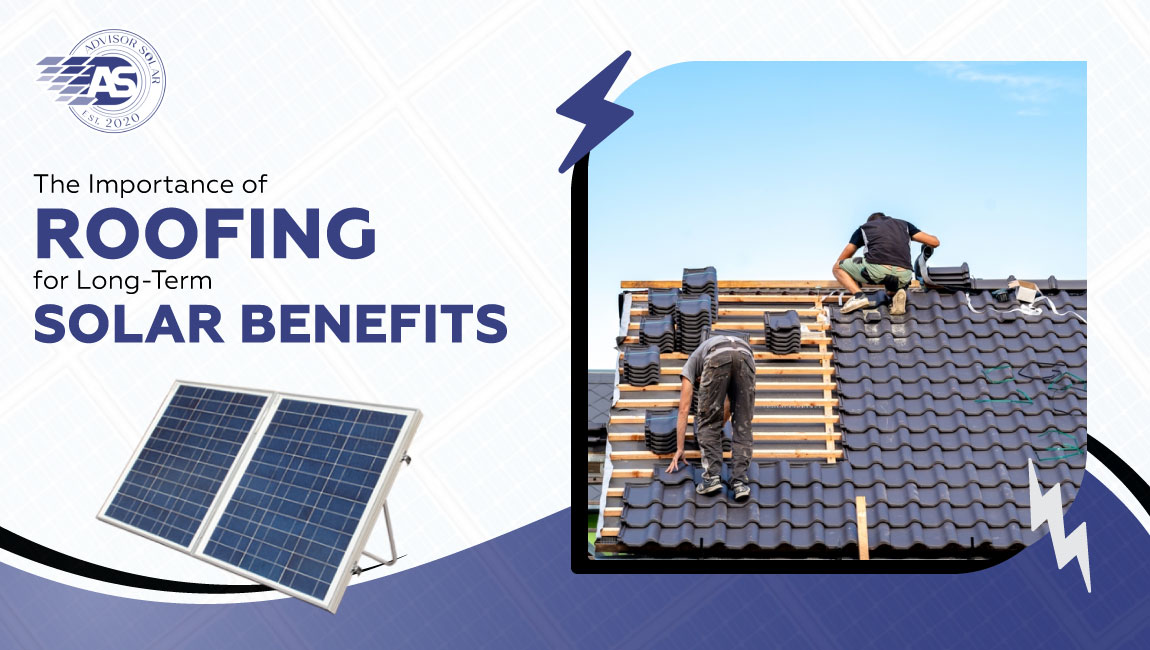When thinking about going solar, most homeowners think they only need solar panels and other important components like a controller and batteries etc. A solar investment for long-term benefits starts from assessing the condition of your roof because it has a high influence on the efficiency and durability of solar systems.
The solid roof makes sure your solar panels work uninterruptedly throughout their life. If the roof has structural issues and it is weak, ignoring this condition may lead to early removal of panels, which can greatly affect your energy supplies and add cost of reinstalling them into your solar investment. It is necessary to maintain the roof before installing a solar system.
In this blog, we will explore why you must consider the roof condition when planning for solar and which type of roofing material works best with solar systems. We will also see how Advisor Solar helps you examine the condition of your roof and its upgradation.

Why Your Roof Matters in a Solar Installation
A solid roof plays an important role in protecting your solar investment by supporting the solar system for a long time. It helps in reducing long-term maintenance costs. Here are some reasons why you should not ignore your roof condition.
- Structural Support for Panel Weight: The solar plates are heavy and add extra weight. Your roof must be strong enough to hold the weight of the solar system for the next 20-25 years.
- Sunlight Exposure: The shape and available open space of your roof determine how much amount of sunlight it receives during the day.
- Durability Under Extreme Weather: The roof should be in ideal condition and must be able to resist bad weather conditions like strong winds and extreme heat.
- Maintenance Accessibility: The roof should have easy access, which is highly recommended and needed for solar cleaning and maintenance.

Top Signs Your Roof Needs Attention Before Solar Installation
It is good to evaluate your roof before getting a solar system on it so that your solar investment will be protected for a long time. If the system is installed on a roof in poor condition, it can cause early removal of the solar system due to the need for maintenance work. Below are some alarming signs that indicate poor roof condition.
- Unnoticed Leaks: Undetected small leaks might look easy, but they can damage the roof and solar system over a long period. It is better not to ignore even small leaks.
- Rooting Wood: Rooting wood reduces the strength of the roof, and it is not safe to install a solar system on it. It might cause complete damage to the roof and solar system.
- Cracked Shingle: A roof with damaged or missing shingles is not suitable for installing a solar system because its surface is not smooth and might need replacement in the future.
- Structural Weakness: Sagging areas in the roof are a sign of structural issues that must be resolved before the installation of a solar system to ensure long-term solar benefits.
- Older Roof: A solid and fresh roof is necessary to make sure your solar system stands on it for a long time. The older roof might need early replacement, which may affect your energy supplies.

Roof Inspection Steps Before Solar Installation
The solar installation process starts with a roof assessment, which is mandatory to ensure long-term solar benefits and protect your investment. A solid roof is important because it affects the efficiency and life of the solar system.
Below are some important steps that are part of a roof inspection.
- On-Site Evaluation of Roof Condition
- Checking Load-Bearing Capacity
- Measuring Slope and Shading
- Recommending Roof Repairs or Replacement
- Personalized Solar Plan According to the Roof Assessment
1. On-Site Evaluation of Roof Condition
This is the first step of roof inspection in which a solar expert evaluates the condition of your roof. He physically examines your roof for its strength and long-term durability.
2. Checking Load-Bearing Capacity
The solar system puts a large amount of weight on roofs, so in this step solar expert assesses the structural strength of your roof and checks if it can bear the load of the solar system.
3. Measuring Slope and Shading
The third step includes the evaluation of the roof for the angle and duration of sunlight. The solar technician examines whether the roof receives enough amount of sunlight to produce the required amount of electricity.
4. Recommending Roof Repairs or Replacement
If any issue is highlighted during the inspection, the solar expert provides recommendations to repair or resolve the issue in the best way possible. Sometimes, the full roof replacement is recommended.
5. Personalized Solar Plan According to the Roof Assessment
After the successful solar inspection, the installer will design a personalized solar system according to your roof’s orientation and strength that produces maximum possible energy.
Schedule a Free Roof + Solar Assessment Today with Advisor Solar
Advisor Solar knows that the roof is the foundation of a successful solar system that provides you with cleaner and cheaper electrical energy. We offer a free roof and solar assessment to help you determine which type of system is best for your home and long-term solar investment. Our solar experts assess the condition of your roof, its strength, and solar potential.
We are a trusted solar company that is working in New Jersey, Pennsylvania, and Delaware with over a decade of experience backed by technical expertise. We are here to guide you, starting from the assessment of your roof to the final steps of solar installation. Book your free roof assessment and solar consultation today!
FAQs
The metal roof is considered best for solar installation because of its durability and high load-bearing capacity. It can stand against harsh weather and extreme climate conditions.
Yes, it is safe, but it is necessary to make sure that your roof is strong and in good condition. A roof inspection is necessary before installing solar panels on it.
It all depends on your energy needs and the load-bearing abilities of your roof. An unnecessary load on the roof can cause weakness in the roof structure.
There is no disadvantage to installing solar panels on the roof, but it helps to protect your roof from extreme heat and bad weather conditions.

